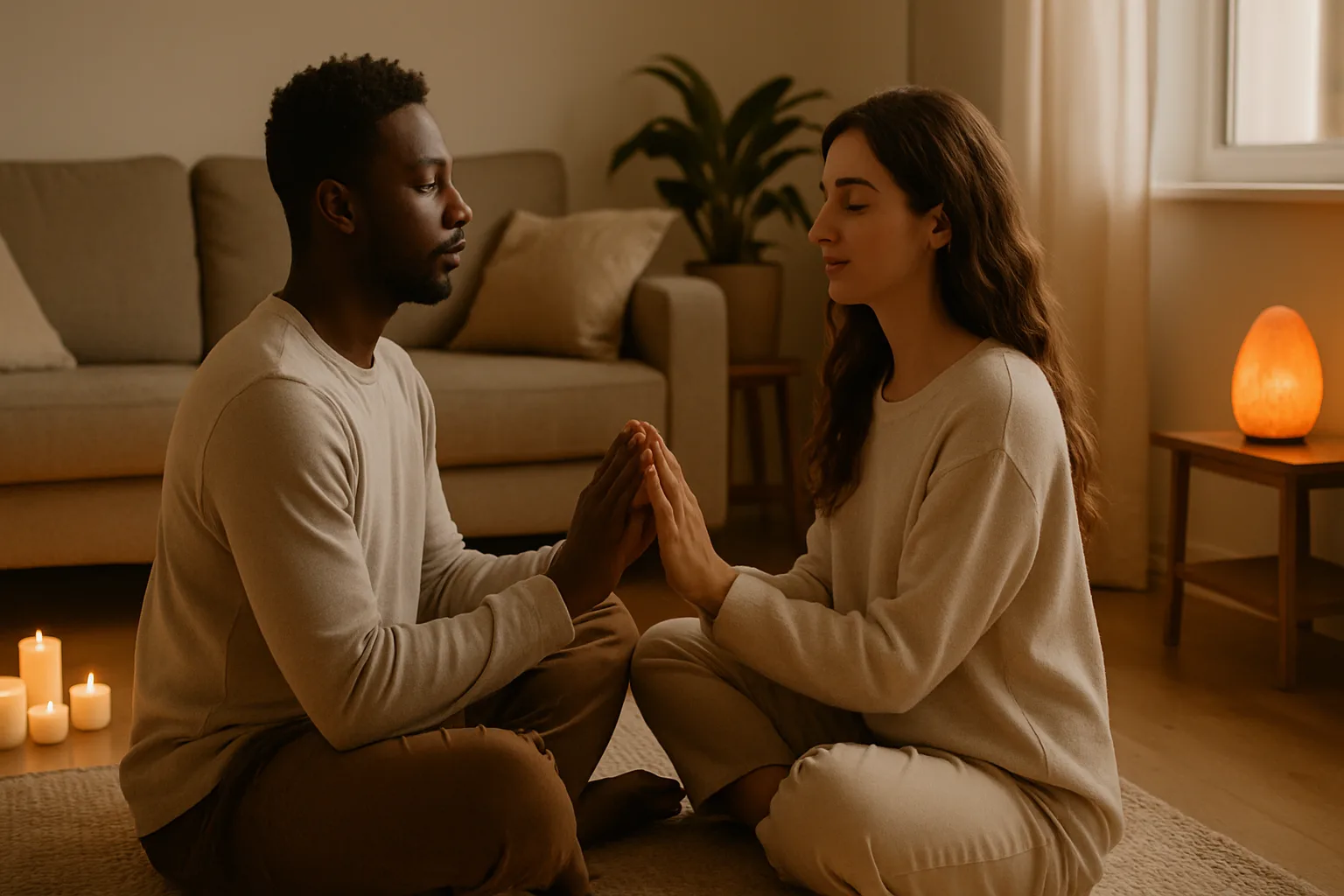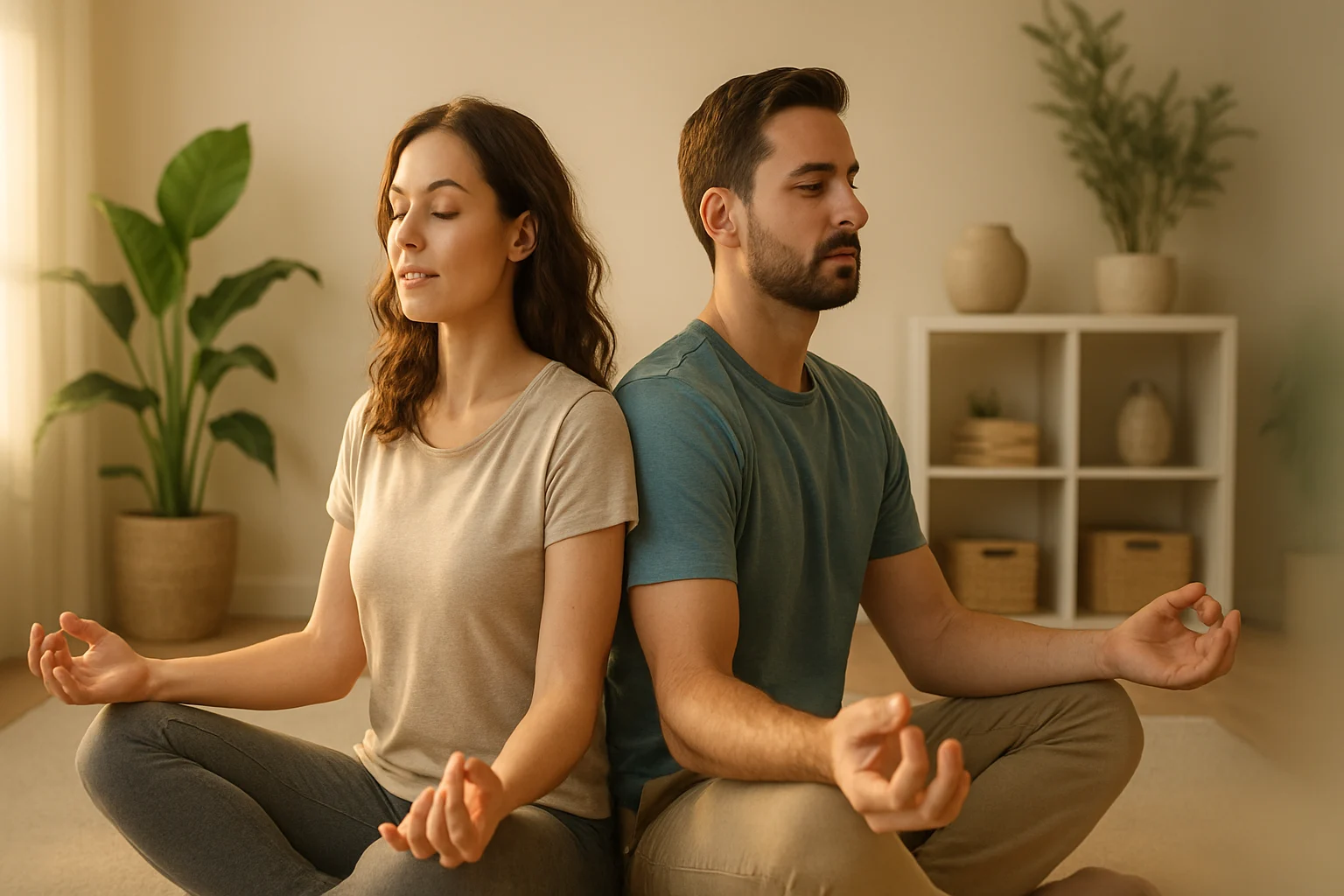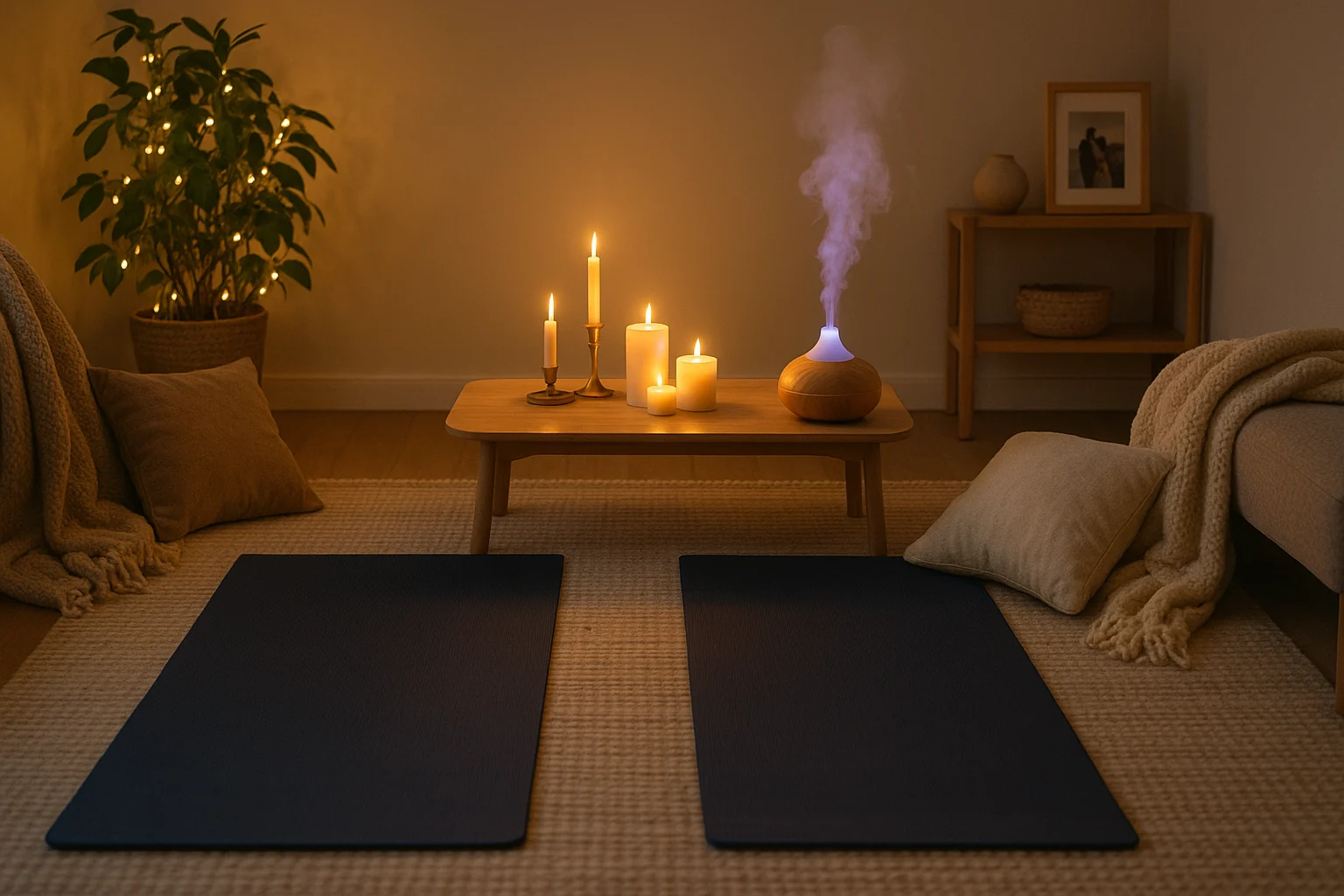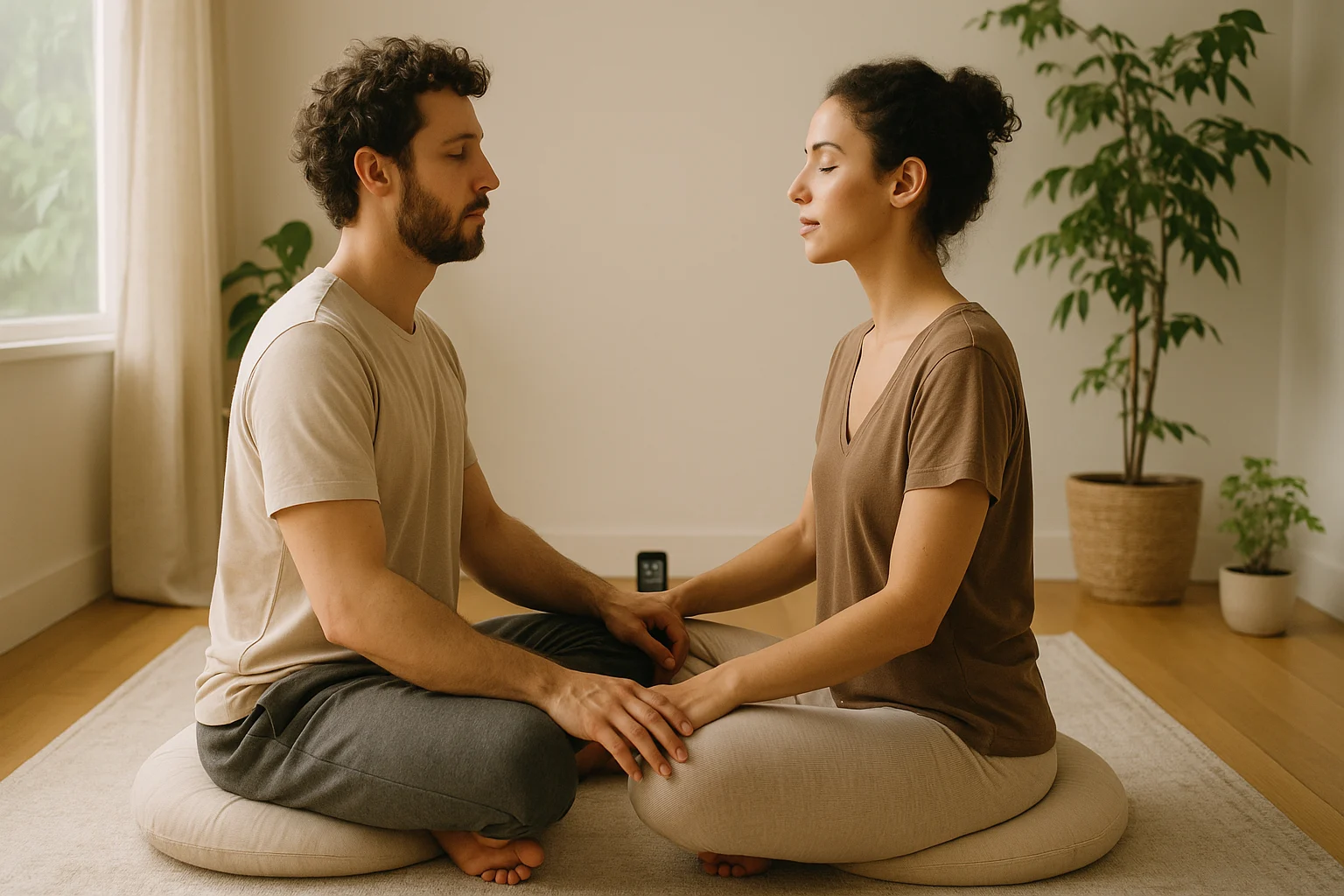
Breathe in. Breathe out. Couples meditation exercises became our five quiet minutes that meant more than any fancy date night. In a busy world, those small moments with your partner deepen your bond in a way that’s all heart. As part of broader relationship wellness explored in our women’s relationship wellness, these simple practices nurture real connection. Whether you’re new to mindfulness or seasoned pros, the steps below will bring you closer over time.
Try an ExerciseTable of Contents
- Key Benefits of Couples Meditation Exercises
- Why Couples Mindfulness Practices Help
- Setting Up Your Couples Meditation Space
- Tips to Start Your Couples Meditation Journey
- 4 Simple Couples Meditation Exercises You’ll Love
- Quick Couples Meditation Guides
- Common Questions About Couples Meditation Exercises
- Overcoming Common Challenges
- Embrace Your Shared Journey
Key Benefits of Couples Meditation Exercises
- Reduced stress: Find a shared calm to ride out life’s wild waves together.
- Enhanced empathy: Really feel your partner’s heart, building a deeper bond.
- Improved communication: Listen with love and sort out conflicts with ease.
- Rekindled intimacy: Spark that emotional and spiritual closeness you both crave.
- Shared growth: Grow as a team through heartfelt, mindful moments.

Why Couples Mindfulness Practices Help
What’s so special about meditating with your partner? It’s the warm glow of couples mindfulness practices that lights up your connection. Partner meditation carves out a shared moment that strengthens the heart of your relationship. Here’s the scoop:
Reduce Stress and Find Shared Calm
When life gets wild, those moments of breathing together feel like coming home. Sitting side by side and syncing our breaths helps dial down stress—and the calm lingers long after. Research backs this up: a 2023 randomized clinical trial found that mindfulness practice lowered hair cortisol (a long-term stress marker) and reduced perceived stress, supporting that shared mindfulness can cultivate a steadier “us.”
Deepen Empathy and Understanding with Meditation for Couples Connection
Mindfulness is about truly seeing your partner, heart and soul. This kind of practice fosters empathy by tuning into their presence without words. For us, eye-gazing felt like peeking into each other’s souls, strengthening our bond. Want more ways to connect? Check out building emotional intimacy with your partner.
Enhance Communication and Conflict Resolution
Regular mindfulness keeps us grounded and present. We listen better, making our talks smoother and more open. When a spat pops up, a quick mindful pause helps us respond with care, not heat, fostering stronger communication and teamwork.
Meditation isn’t about shutting off thoughts—it’s about meeting them with kindness. Together, you see each other with that same warmth!
Rekindle Intimacy and Affection
Intimacy’s more than physical—it’s emotional and spiritual too. Meditation for couples connection, like eye-gazing, sparks closeness through shared, vulnerable moments. My partner and I found it reignited our spark after years of routine, much like Sarah and John from Seattle. These practices remind you why you fell in love.
Foster Shared Growth and Purpose
Meditating together feels like a quiet vow to grow—both on your own and as a couple. Rooting for each other adds a warm spark to our relationship. That shared purpose keeps us grounded, always nudging us that we’re building a life together. Honestly, what’s sweeter than that?
Setting Up Your Couples Meditation Space
Before jumping into your mindfulness practice together, create a cozy, distraction-free haven. A little love here makes couples meditation exercises feel like a special ritual, full of focus and connection.
Choose a Quiet Spot
Pick a peaceful corner of your home—maybe a quiet nook bathed in morning light, your bedroom, or a garden with sunlight dancing through the leaves. Ensure there’s enough space for comfort.
Minimize Distractions
Turn off phones, tablets, and TVs to avoid notifications and create a calm space. Let others know you need a quiet moment. Shut doors or windows to muffle outside noise, creating a serene bubble with the gentle hum of quiet for you and your partner.
Ensure Comfort
Grab some cushions, a soft blanket, or chairs to keep you cozy. Sit cross-legged, on chairs with feet flat, or lie down with a pillow propping your head. Feeling comfy lets you sink right into the moment.
Create a Calming Ambiance
Dim the lights or light a candle for a heart-warming glow. The scent of lavender from a diffuser or soft music can work wonders, though we sometimes just soak in pure silence. Talk with your partner to find what vibes best. A little effort here turns your partner practice into a special ritual—focused and deeply connecting.
Set a Shared Intention
Before you dive in, agree on what you’re chasing—connection, stress relief, or just some quality time. A shared mindfulness ritual shines when you’re both in sync, laying a solid foundation for your session.

This post has affiliate links. We may earn a commission. Learn more.
Tips to Start Your Couples Meditation Journey
Starting a partner meditation routine can feel a bit weird—I still blush thinking about our first try, giggling like total newbies! Stick with it; the payoff is real. Here’s how to ease in, no fuss:
Begin with Short Sessions
I still chuckle at our first clumsy attempt—just 5–10 minutes can spark a deeper connection. Even quick sessions can nurture your bond. Build up time as you get comfy—it’s a journey, not a race!
Communicate Openly
After a session, have a heart-to-heart about how it felt. Share what surprised you or felt tricky, no judgment here. This openness deepens your bond and tweaks your practice. Check out communicating needs in a relationship for more tips.
The best relationship talks often bloom after meditation, when you’re both open and connected.
Embrace Imperfection
Your mind might wander, or you’ll burst out laughing—no biggie! Don’t chase perfection. Laugh off distractions and gently return to the moment together.
Make It a Ritual
Pick a regular time—mornings, evenings, or a quick midday pause. Turning it into a habit makes meditation something you both look forward to.
Explore Together
If one exercise doesn’t vibe, try another. Play with guided meditations or create your own. It’s a fun way to bond! Complement it with intimacy exercises for couples for extra variety.
4 Simple Couples Meditation Exercises You’ll Love
These beginner-friendly practices need no experience and build a deep connection. Pick one and dive in!
Exercise 1: Synchronized Breath Meditation
There’s nothing like breathing together to feel totally in tune. Couples mindfulness practices like this one make connection feel effortless.
- Why it works: Syncing breaths aligns your nervous systems, melting away distance and boosting shared calm.
- How to do it:
- Sit comfortably: Face each other or sit side-by-side, holding hands or resting them on your knees.
- Close eyes: Or soften your gaze to tune out distractions.
- Notice your breath: Feel your breath flow for 1–2 minutes, no forcing needed.
- Sync with faction: Gently match your partner’s inhale and exhale.
- Breathe as one: Keep going for 5–10 minutes, nudging your focus back if it wanders.
- Conclude: Open your eyes and soak in a quiet, shared moment.
Exercise 2: Eye-Gazing for Soulful Connection
This practice deepens intimacy with steady eye contact. There’s something downright magical about locking eyes in silence!
- Why it works: Eye-gazing builds a wordless connection, stirring up vulnerability and love.
- How to do it:
- Sit close: Face each other, close enough to see those eyes sparkle.
- Set intention: Agree to be fully open and present.
- Gaze softly: Lock eyes gently, picking one eye to focus on.
- Breathe naturally: Let thoughts or giggles float by, no judgment.
- Stay present: If you look away or laugh, ease back into the gaze.
- Continue: Start with 2–3 minutes, building to 5–10.
- Conclude: Close your eyes, then share a smile or gentle touch.
Exercise 3: Heart-Centered Gratitude Practice
This practice nurtures appreciation by zeroing in on what you love about your relationship. Gratitude work shines here, deepening your emotional bond.
- Why it works: Gratitude lifts your spirits and strengthens your bond by spotlighting shared joys.
- How to do it:
- Sit comfortably: Side-by-side or facing each other, maybe holding hands.
- Close eyes: Turn your focus inward, nice and easy.
- Touch heart: Rest a hand on your heart to tap into those feelings.
- Reflect on gratitude: Think of what you cherish about your partner or your shared life.
- Feel it: Let that gratitude warm you from the inside out.
- Share (optional): Take turns sharing one thing you’re thankful for, letting those words sink in.
- Conclude: Keep going for 5–15 minutes, then share a heart-warming glance.

Quick Couples Meditation Guides
Choose a practice below to open a short, warm-toned guide you can follow together in minutes.
How to Practice Synchronized Breath
- Sit facing or side-by-side; relax shoulders.
- Notice natural breathing for 60–120 seconds.
- Match inhales and exhales gently for 5–10 minutes.
- End with a quiet smile or squeeze of the hand.
How to Practice Eye-Gazing
- Sit close; agree to stay present and kind.
- Soften your gaze on one eye; breathe naturally.
- Hold for 2–5 minutes; return if giggles happen.
- Close eyes, then share a gentle touch.
How to Practice Heart Gratitude
- Place a hand on your heart; breathe slowly.
- Each shares one thing they appreciate.
- Feel the warmth for 3–5 minutes.
- Seal it with a smile or hug.
Common Questions About Couples Meditation Exercises
Overcoming Common Challenges
My partner’s skeptical smirk when we first tried meditating together still makes me chuckle! Couples-focused mindfulness, like synchronized breathing, is perfect for easing a hesitant partner in gently. Have an open chat about any doubts, and start with short sessions to build comfort. Ready for more? Deeper practices like guided loving-kindness meditation can lift your connection to new heights.
Embrace Your Shared Journey
These shared mindfulness rituals are like a warm hug for your relationship—imperfect, real, and deeply connecting. It’s not about being perfect but about cherishing those quiet, heart-melting moments together. Stay patient, keep the conversation flowing, and celebrate every little step. Whether you’re syncing breaths or sharing gratitude, meditation for couples connection builds a stronger, more loving bond. Start today and feel your hearts grow closer!